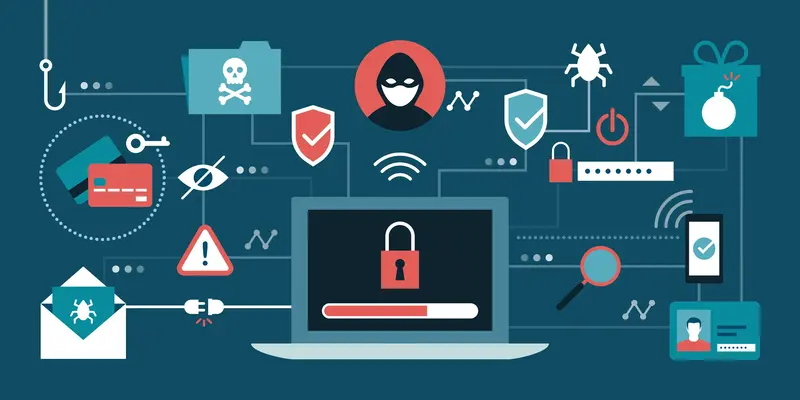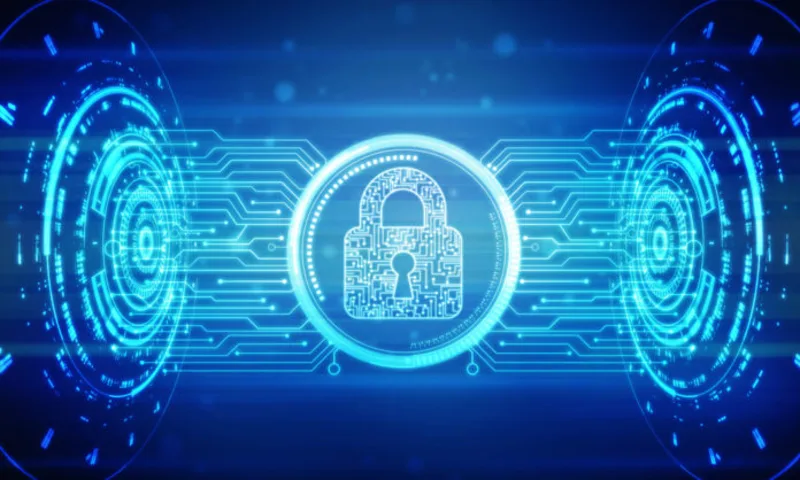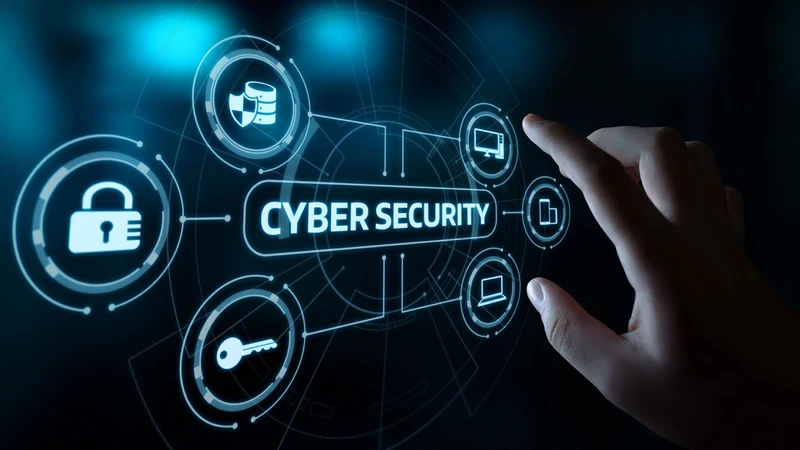Quick Link
Cybersecurity Threat Landscape
As 2024 approaches, new risks and clever attack techniques continue to surface in this dynamic field of cybersecurity. Cybersecurity procedures are becoming more and more necessary as personal, corporate, and government data become more digitalised. This extensive article will go into the changing nature of cyberthreats in 2024 as well as potential remedies.

Increasing Digitization
The way people live and conduct business has changed due to the unstoppable expansion of digital technologies. It has many benefits, many advantages. The landscape of cybersecurity threats is expanding, putting people more vulnerable to cyberattacks due to developments in cloud computing, IoT devices, artificial intelligence, and 5G connection. All of these factors work together to increase the likelihood of cyberattacks as systems grow more interconnected, giving the attacker access to a larger and larger attack surface. It provides cybersecurity challenges that vary from people to major organizations
Complicated Threat Actors Increasing
As time unfolds in 2024, cybersecurity challenges will not only be from amateur hackers but also from sophisticated threat actors: nation-states, organized crime groups, and corporate espionage companies. Cybersecurity measures must improve at the same rate as these actors, who will employ sophisticated methods and instruments to achieve their goals.
Upcoming Threats in 2024
Advanced Ransomware Attacks
Evolution of Ransomware Tactics
Since ransomware attacks only encrypted some files, time has passed. The Cybersecurity Threat Landscape of 2024 shows that different strategies are being used, including double extortion, in which sensitive material is not only encrypted but also threatened to be published unless a ransom is paid, increasing pressure to comply with demands.
Targeted Attacks
These are now the ransomware gangs that target well-known targets, like important infrastructure and big businesses, resulting in significant disruptions and monetary losses. In-depth reconnaissance is now a part of the modus operandi to find vulnerabilities and tailor the attack for optimal effect.
Advanced Detection and Response
Advanced reaction and detection systems are necessary for sophisticated ransomware. This include deploying endpoint detection and response tools, having reliable backup plans, and keeping all systems and software up to date with the most recent fixes. To aid in a speedy recovery after an attack, an incident response plan can also be prepared.
AI-Powered Cyber Threats
Machine Learning in Cyber Attacks
As a result, the bad guys are depending more and more on automated, detection-avoiding machine learning and artificial intelligence (AI) attacks. Volumes of data may be examined with far greater efficiency and accuracy using AI-powered technologies to identify vulnerabilities, launch phishing operations, or even create new malware strains.
Deepfakes and Synthetic Media
Although deepfake technology produces incredibly lifelike audio and video content, it isn’t real. It has been utilised in social engineering attacks lately. Cybersecurity Threat Landscape: To achieve deception, sway public opinion, or aid in fraud, attackers might pose as anyone or produce false content with a target.
Solution-AI-Enhanced Security Solutions
Stated differently, the cybersecurity defence must incorporate AI and machine learning to counteract these threats driven by AI. Artificial intelligence-powered security solutions will search for abnormalities in patterns, allowing for early alerts against possible threats. The capacity to recognise and address new threats is enhanced by this ongoing training of AI models combined with threat intelligence feeds.
IoT Vulnerabilities
Increasing Attack Surface:
As a result, a variety of vulnerabilities have been incorporated into everyday life, appearing in places ranging from offices and homes to factories. The majority of Internet of Things devices have lax security safeguards, making them easily hackable. IoT devices that have been compromised can be utilised in a botnet or as a point of entry for broader attacks according to the Cybersecurity Threat Landscape.
Data Privacy Issues:
IoT devices are frequently made with the intention of collecting a great deal of personal data from its users, which presents grave privacy issues. Such private information may be exposed by insecure devices, leading to data breaches and privacy violations.
Solution-IoT Security Standards and Monitoring
Ensuring that security requirements are strictly implemented is a crucial step in addressing vulnerabilities related to IoT. This will involve using strong authentication, updating firmwares on a regular basis, and segmenting networks of Internet of Things devices. Constant surveillance and threat intelligence will guarantee the identification of anomalous activities and stop breaches of all kinds.
Challenges in Cloud Security
Poorly Configured Cloud Services:
Cloud service misconfigurations could become a major danger as more and more businesses move their operations online. Improper configuration of cloud storage can lead to data leaks and unauthorised access to important data. Inappropriate alignment of the shared responsibility paradigm between cloud providers and clients can occasionally lead to the development of security vulnerabilities.
Cloud-Native Threats:
Particular dangers associated with cloud environments include serverless computing and vulnerabilities in containers. An attacker may employ cloud-native apps to take advantage of security holes or exploit cloud resources to launch an attack.
Solution-Best Practices in Cloud Security
Reducing Cloud Security Challenges: Strict access control, regular cloud setting reviews and audits, and the implementation of all-encompassing cloud security solutions for total visibility and asset protection are among the best practices followed by organisations. Moreover, security will be ensured by encrypting data while it is in transit and at rest.
Quantum Computing Threats
Quantum Cryptography Risks:
Due to the possibility of quantum computing breaking conventional encryption schemes, this could endanger data secrecy. The potential for quantum computers to answer complicated mathematical problems faster than a classic computer might potentially undermine established cryptography techniques by solving problems that can currently take a long time for a classic computer to solve.

Post-Quantum Cryptography:
It is essential to create cryptographic methods that can fend off these attacks since quantum computing has arrived. This makes it necessary to urge organisations to get ready to switch to more advanced encryption techniques that maintain their security without putting it at risk anytime soon.
Solution-Quantum Resistant Encryption
Researchers and organisations have been working on a variety of quantum-resistant encryption algorithms in response to the concerns posed by quantum computing, and a significant amount of effort is being made towards standardising these algorithms. There are currently hybrid encryption techniques in use, and staying up to date with the ongoing developments in quantum-resistant cryptography will make us more equipped for the world of quantum computing.
Insider Threats
Growing Concern:
Insider threats continue to be a major source of both purposeful and inadvertent dangers. Access to confidential information by workers and contractors may result in data breaches or improper use of access rights. If the insider is knowledgeable about security procedures, these are frequently difficult to identify or stop.
Solution-Insider Threat Programs
The deployment of insider threat programs by an organisation through user activity monitoring, least-privilege access controls, and security awareness training is known as insider threat mitigation. Using behavioural analytics to analyse abnormalities that can potentially point to insider threats is part of this.
Supply Chain Attacks
Complex Attack Vectors:
Attacks on supply chains involve compromising a third party or using a vendor to get access to the target systems. Since these attacks often foster confidence between businesses and their suppliers, they are difficult to identify and stop.

Supply Chain Attacks: High-Profile Incidents:
This kind of danger can have an impact, as evidenced by a few high-profile supply chain attacks in recent years. To attack several organisations at once, the attackers might compromise hardware or software updates.
Solution-Security of the Supply Chain
Strict implementation of security regulations, anomalous activity monitoring, and stringent security evaluation procedures for third-party providers are effective ways to mitigate supply chain assaults. In addition to regular security audits, software supply chain management technologies are useful since they aid in risk discovery and mitigation.
Solutions and Best Practices for 2024
Zero Trust Architecture
Zero Trust: A security approach predicated on no implied trust within and outside of an organization’s network. Regardless of location, users and devices should always be verified. By minimising unwanted access and lowering the chance of a data breach, the model will address the issue of current security challenges.
Implementation Strategies
Strict access control, device segmentation, and ongoing user and device activity monitoring are all part of zero trust. The foundation of a Zero Trust architecture consists of several ideas, the most important of which are least-privilege access regulations and multi-factor authentication.
Advanced Threat Detection and Response
Integrate AI and Machine Learning:
Advanced Threat Detection and Response Systems: These systems search through enormous amounts of data for possible threats using artificial intelligence (AI) and machine learning. These solutions enable automatic reactions aimed at risk removal and provide real-time notifications.
Incident Response Planning:
An organisation may manage and mitigate the effects of a cybersecurity event with the use of an effective incident response plan. To react as quickly as possible to any potential risks, the organisation needs to be ready to create and test incident response strategies.
Continuous Security Training
Training of Employees:
One of the most common causes of cybersecurity accidents is still human factors. Employees can detect potential risks such as social engineering and phishing attempts with the aid of security awareness and training programs.
Training Programs and Simulations:
Frequent training sessions, including as security workshops and simulated phishing exercises, may reinforce best practices and guarantee that staff members are prepared for new threats.
Encryption and Data Protection
Data Encryption:
The foundation of any data security is encryption. The data at rest and in transit should be safeguarded with modern encryption techniques, retaining integrity and confidentiality.
Data Loss Prevention:
Solutions for preventing data loss give an organisation the ability to monitor and shield confidential information from theft or unauthorised access. In order to achieve data security and meet requirements related to regulatory compliance, DLP practices and strategies are also essential.
Regulatory Compliance and Governance
Compliance to Standards:
Numerous cybersecurity laws and guidelines support data protection, which in turn supports maintaining confidence. An organisation should keep up with any rules that may impact its operations and align its security procedures with industry norms and best practices.
Governance Frameworks:
By putting governance frameworks into place, a company may create and uphold its security policies and procedures. It may be necessary to conduct routine audits and assessments to make sure that the security policies are being followed and to identify areas for further improvement.
Final Thoughts
As we venture closer into the year 2024, the cybersecurity environment continues to entail fresh difficulties with new opportunities. Some of the rapidly developing dangers include advanced ransomware, AI-powered attacks, and IoT vulnerabilities; proactive and adaptive protection is necessary toward these growing threats. For any real defence against such threats and to safeguard digital assets, it is now imperative that sophisticated detection and response systems be put in place, Zero Trust architecture be adopted, and ongoing training in security and data protection be guaranteed.
The ever-changing field of cybersecurity demands extreme caution and creativity. Our defence strategies must also evolve along with technology. Keeping it in mind, coupled with informed best practices, will help an organization to understand such a complex cybersecurity ecosystem and guarantee that it remains resilient against all kinds of threats.
For more content like this visit for online earning blogs visit autoearn or visit our facebook page.




